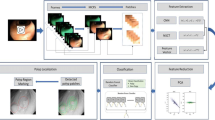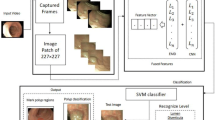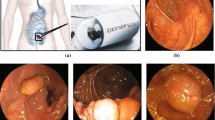Abstract
Gastrointestinal polyps are treated as the precursors of cancer development. So, possibility of cancers can be reduced at a great extent by early detection and removal of polyps. The most used diagnostic modality for gastrointestinal polyps is video endoscopy. But, as an operator dependant procedure, several human factors can lead to miss detection of polyps. In this peper, an improved computer aided polyp detection method has been proposed. Proposed improved method can reduce polyp miss detection rate and assists doctors in finding the most important regions to pay attention. Color wavelet features and convolutional neural network features are extracted from endoscopic images, which are used for training a support vector machine. Then a target endoscopic image will be given to the classifier as input in order to find whether it contains any polyp or not. If polyp is found, it will be marked automatically. Experiment shows that, color wavelet features and convolutional neural network features together construct a highly representative of endoscopic polyp images. Evaluations on standard public databases show that, proposed system outperforms state-of-the-art methods, gaining accuracy of 98.34%, sensitivity of 98.67% and specificity of 98.23%. In this paper, the strength of color wavelet features and power of convolutional neural network features are combined. Fusion of these two methodology and use of support vector machine results in an improved method for gastrointestinal polyp detection. An analysis of ROC reveals that, proposed method can be used for polyp detection purposes with greater accuracy than state-of-the-art methods.






Similar content being viewed by others
References
Karkanis SA, et al. Computer-aided tumor detection in endoscopic video using color wavelet features. IEEE Trans Inf Technol Biomed. 2003;7(3):141–52.
Iakovidis DK, Maroulis DE, Karkanis SA. An intelligent system for automatic detection of gastrointestinal adenomas in video endoscopy. Comput Biol Med. 2006;36(10):1084–103.
Kodogiannis V, Boulougoura M. An adaptive neurofuzzy approach for the diagnosis in wireless capsule endoscopy imaging. Int J Inf Technol. 2007;13(1):46–56.
Alexandre LA, Nobre N, Casteleiro J. Color and position versus texture features for endoscopic polyp detection. In: International conference on biomedical engineering and informatics, 2008. BMEI 2008. Vol. 2. IEEE; 2008.
Li B, et al. Intestinal polyp recognition in capsule endoscopy images using color and shape features. In: 2009 IEEE international conference on robotics and biomimetics (ROBIO). IEEE; 2009.
Zou Y, et al. Classifying digestive organs in wireless capsule endoscopy images based on deep convolutional neural network. In: 2015 IEEE international conference on digital signal processing (DSP). IEEE; 2015.
Zhu R, Zhang R, Xue D. Lesion detection of endoscopy images based on convolutional neural network features. In: 2015 8th international congress on image and signal processing (CISP). IEEE; 2015.
Tajbakhsh N, Gurudu SR, Liang J. Automatic polyp detection using global geometric constraints and local intensity variation patterns. In: International conference on medical image computing and computer-assisted intervention. Springer; 2014.
Ribeiro E, Uhl A, Häfner M. Colonic polyp classification with convolutional neural networks. In: 2016 IEEE 29th international symposium on computer-based medical systems (CBMS). IEEE; 2016.
Tajbakhsh N, Gurudu SR, Liang J. Automatic polyp detection in colonoscopy videos using an ensemble of convolutional neural networks. In: 2015 IEEE 12th international symposium on biomedical imaging (ISBI). IEEE; 2015.
Jia X, Meng MQH. A deep convolutional neural network for bleeding detection in wireless capsule endoscopy images. In: 2016 IEEE 38th annual international conference of the engineering in medicine and biology society (EMBC). IEEE; 2016.
Ribeiro E, et al. Exploring deep learning and transfer learning for colonic polyp classification. Comput Math Methods Med. 2016;2016:368.
Park SY, Sargent D. Colonoscopic polyp detection using convolutional neural networks. In: SPIE medical imaging. International Society for Optics and Photonics; 2016.
Mesejo P, et al. Computer-aided classification of gastrointestinal lesions in regular colonoscopy. IEEE Trans Med Imaging. 2016;35(9):2051–63.
Bernal J, et al. Comparative validation of polyp detection methods in video colonoscopy: results from the MICCAI 2015 endoscopic vision challenge. IEEE Trans Med Imaging. 2017;36:1231–49.
Krizhevsky A, Sutskever I, Hinton GE. Imagenet classification with deep convolutional neural networks. In: Advances in neural information processing systems; 2012. P. 1097–1105.
Donahue J, et al. DeCAF: a deep convolutional activation feature for generic visual recognition. In: Icml, Vol. 32; 2014.
Haralick RM. Statistical and structural approaches to texture. Proc IEEE. 1979;67(5):786–804.
Haralick RM, Shanmugam K. Textural features for image classification. IEEE Trans Syst Man Cybern. 1973;3(6):610–21.
West D, West V. Model selection for a medical diagnostic decision support system: a breast cancer detection case. Artif Intell Med. 2000;20(3):183–204.
Baxt WG. Application of artificial neural networks to clinical medicine. Lancet. 1995;346(8983):1135–8.
El-Naqa I, et al. A support vector machine approach for detection of microcalcifications. IEEE Trans Med Imaging. 2002;21(12):1552–63.
Goszczyński J. Texture classification using support vector machine. Pattern Recogn. 2003;36:2883–93.
Gokturk SB, et al. A statistical 3-D pattern processing method for computer-aided detection of polyps in CT colonography. IEEE Trans Med Imaging. 2001;20(12):1251–60.
Author information
Authors and Affiliations
Corresponding author
Ethics declarations
Conflict of interest
The authors declare that, there is no conflict of interest regarding this paper.
Ethical standard
All procedures performed in this study involving human participants were in accordance with the ethical standards of the institutional and/or national research committee and with the 1964 Helsinki declaration and its later amendments or comparable ethical standards.
Rights and permissions
About this article
Cite this article
Billah, M., Waheed, S. Gastrointestinal polyp detection in endoscopic images using an improved feature extraction method. Biomed. Eng. Lett. 8, 69–75 (2018). https://doi.org/10.1007/s13534-017-0048-x
Received:
Revised:
Accepted:
Published:
Issue Date:
DOI: https://doi.org/10.1007/s13534-017-0048-x




